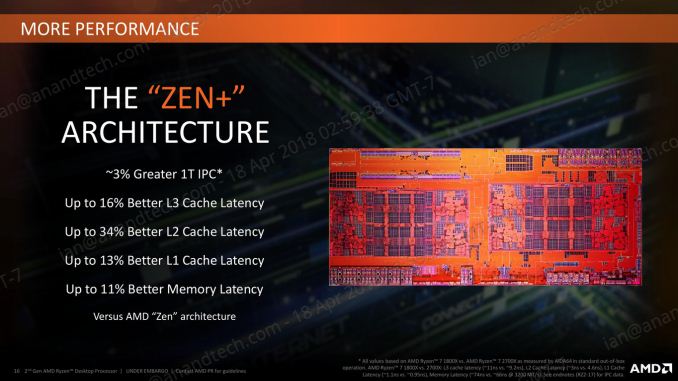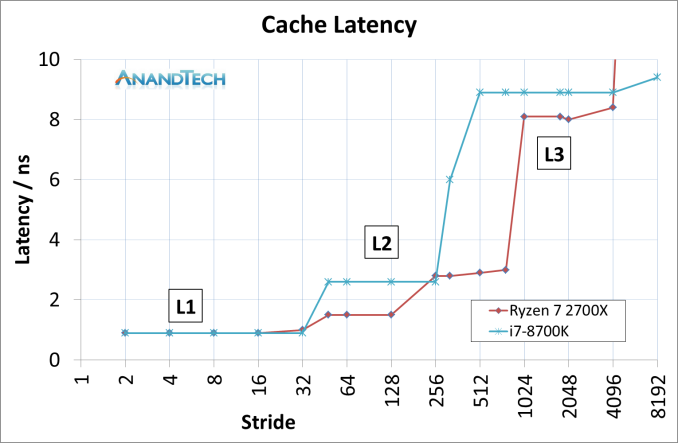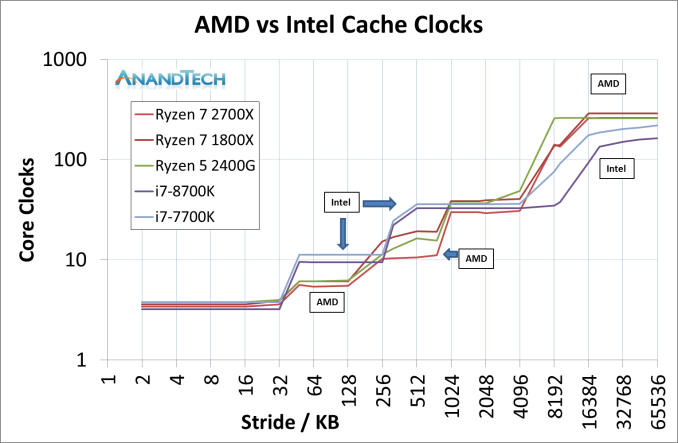The AMD 2nd Gen Ryzen Deep Dive: The 2700X, 2700, 2600X, and 2600 Tested
by Ian Cutress on April 19, 2018 9:00 AM ESTImprovements to the Cache Hierarchy
The biggest under-the-hood change for the Ryzen 2000-series processors is in the cache latency. AMD is claiming that they were able to knock one-cycle from L1 and L2 caches, several cycles from L3, and better DRAM performance. Because pure core IPC is intimately intertwined with the caches (the size, the latency, the bandwidth), these new numbers are leading AMD to claim that these new processors can offer a +3% IPC gain over the previous generation.
The numbers AMD gives are:
- 13% Better L1 Latency (1.10ns vs 0.95ns)
- 34% Better L2 Latency (4.6ns vs 3.0ns)
- 16% Better L3 Latency (11.0ns vs 9.2ns)
- 11% Better Memory Latency (74ns vs 66ns at DDR4-3200)
- Increased DRAM Frequency Support (DDR4-2666 vs DDR4-2933)
It is interesting that in the official slide deck AMD quotes latency measured as time, although in private conversations in our briefing it was discussed in terms of clock cycles. Ultimately latency measured as time can take advantage of other internal enhancements; however a pure engineer prefers to discuss clock cycles.
Naturally we went ahead to test the two aspects of this equation: are the cache metrics actually lower, and do we get an IPC uplift?
Cache Me Ousside, How Bow Dah?
For our testing, we use a memory latency checker over the stride range of the cache hierarchy of a single core. For this test we used the following:
- Ryzen 7 2700X (Zen+)
- Ryzen 5 2400G (Zen APU)
- Ryzen 7 1800X (Zen)
- Intel Core i7-8700K (Coffee Lake)
- Intel Core i7-7700K (Kaby Lake)
The most obvious comparison is between the AMD processors. Here we have the Ryzen 7 1800X from the initial launch, the Ryzen 5 2400G APU that pairs Zen cores with Vega graphics, and the new Ryzen 7 2700X processor.
This graph is logarithmic in both axes.
This graph shows that in every phase of the cache design, the newest Ryzen 7 2700X requires fewer core clocks. The biggest difference is on the L2 cache latency, but L3 has a sizeable gain as well. The reason that the L2 gain is so large, especially between the 1800X and 2700X, is an interesting story.
When AMD first launched the Ryzen 7 1800X, the L2 latency was tested and listed at 17 clocks. This was a little high – it turns out that the engineers had intended for the L2 latency to be 12 clocks initially, but run out of time to tune the firmware and layout before sending the design off to be manufactured, leaving 17 cycles as the best compromise based on what the design was capable of and did not cause issues. With Threadripper and the Ryzen APUs, AMD tweaked the design enough to hit an L2 latency of 12 cycles, which was not specifically promoted at the time despite the benefits it provides. Now with the Ryzen 2000-series, AMD has reduced it down further to 11 cycles. We were told that this was due to both the new manufacturing process but also additional tweaks made to ensure signal coherency. In our testing, we actually saw an average L2 latency of 10.4 cycles, down from 16.9 cycles in on the Ryzen 7 1800X.
The L3 difference is a little unexpected: AMD stated a 16% better latency: 11.0 ns to 9.2 ns. We saw a change from 10.7 ns to 8.1 ns, which was a drop from 39 cycles to 30 cycles.
Of course, we could not go without comparing AMD to Intel. This is where it got very interesting. Now the cache configurations between the Ryzen 7 2700X and Core i7-8700K are different:
| CPU Cache uArch Comparison | ||
| AMD Zen (Ryzen 1000) Zen+ (Ryzen 2000) |
Intel Kaby Lake (Core 7000) Coffee Lake (Core 8000) |
|
| L1-I Size | 64 KB/core | 32 KB/core |
| L1-I Assoc | 4-way | 8-way |
| L1-D Size | 32 KB/core | 32 KB/core |
| L1-D Assoc | 8-way | 8-way |
| L2 Size | 512 KB/core | 256 KB/core |
| L2 Assoc | 8-way | 4-way |
| L3 Size | 8 MB/CCX (2 MB/core) |
2 MB/core |
| L3 Assoc | 16-way | 16-way |
| L3 Type | Victim | Write-back |
AMD has a larger L2 cache, however the AMD L3 cache is a non-inclusive victim cache, which means it cannot be pre-fetched into unlike the Intel L3 cache.
This was an unexpected result, but we can see clearly that AMD has a latency timing advantage across the L2 and L3 caches. There is a sizable difference in DRAM, however the core performance metrics are here in the lower caches.
We can expand this out to include the three AMD chips, as well as Intel’s Coffee Lake and Kaby Lake cores.
This is a graph using cycles rather than timing latency: Intel has a small L1 advantage, however the larger L2 caches in AMD’s Zen designs mean that Intel has to hit the higher latency L3 earlier. Intel makes quick work of DRAM cycle latency however.














545 Comments
View All Comments
Aichon - Tuesday, April 24, 2018 - link
Wouldn’t it actually suggest that there’s a difference between your setup and theirs that favors yours? For instance, in the case of your earlier benchmark, you admittedly overclocked your 1600X and they didn’t, so don’t you think that might account for the 10% difference you saw over theirs? And in the case of the 8700K, you omitted key contextual information (e.g. is your system updated, and if so, which updates to what components?) that would allow others to verify that it was an apples-to-apples comparison.Ryan may very well have made a mistake and you may very well be entirely correct about all of this, but claiming he’s a liar on the basis of your overclocked system and then following it up with claims about the 8700K that lack the information necessary for someone else to verify your data does not help your case.
Meanwhile, my horse in this race died years ago. The latest product I bought from either teams red or blue was a 2011 Mac Mini that had an Intel CPU and an AMD GPU. All of which is to say, I’m a fan of passionate debate, but let’s keep aspersions to a minimum and focus on getting to the truth.
tn_techie - Thursday, April 19, 2018 - link
On the first paragraph, Ian writes the following:"This is not AMD’s next big microarchitecture, which we know is called Rome (or Zen 2) on 7nm."
That is incorrect. Rome is the codename for the upcoming EPYC 2nd Gen CPUs that will replace the current Naples products, and not the codename for AMD's next gen CPU core arch.
msroadkill612 - Thursday, April 19, 2018 - link
"anything that is hard on a single-threaded, such as our FCAT test or Cinebench 1T, Intel wins hands down"Yeah, I know, its just an indicator, but it's telling that the test seems as silly as the emphasis on ipc due to shrill/shill gamers - who would use single thread for cinebench?
Luckz - Monday, April 23, 2018 - link
Single thread Cinebench 15 score is *the* indicator of IPC used in meme-filled debates on online forums. It's just an important metric right now. And unlike, uh, GeekBench, CPU-Z, and whatever else claims to judge single thread score, it's pretty accurate.peevee - Thursday, April 19, 2018 - link
"ranging from the Silent 65W Wraith models"You mean Stealth, right?
Ryan Smith - Thursday, April 19, 2018 - link
Indeed we do. Thanks!fallaha56 - Thursday, April 19, 2018 - link
Techradar also confirming massive performance hit from Intel patchesEg 1000points in single core Geekbench
ACE76 - Thursday, April 19, 2018 - link
Techradar has AMD beating Intel in pretty much everything...I guess Intel fanboys could just run their systems unpatched and claim to be kings...lol.msroadkill612 - Thursday, April 19, 2018 - link
My memory is bad, but not that bad.I read a lot of cpu reviews, and this is the first that has made it clear that these are post security patch.
Could this be the first honest comparison review of ryzen - new OR old?
It certainly stirred a fanboi wasp nest.
ACE76 - Thursday, April 19, 2018 - link
Anandtech isn't alone... Techradar has AMD winning on fully patched systems as well...the sites that have Intel winning are using either old scores or unpatched systems for Smeltdown.